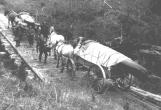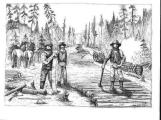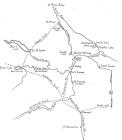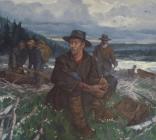1
Albert Huble and Edward Seebach often hauled loads of cargo and watercraft across the portage1915
Huble Homestead/Giscome Portage on the Fraser River, North of Prince George, British Columbia, Canada

2
Hauling freight over the Giscome Portage, 19153
INTRODUCTIONThis paper is about a crucial transportation link to the Peace River region and two entrepreneurs who had the foresight to develop commerce around that link. During the second half of the 19th century, the Cariboo and the Peace River area enjoyed an influx of people (mainly men) who prospected for gold in the gold rushes known as the Cariboo gold rush and the Omineca gold rush, respectively. The Cariboo gold rush spurred the development of a wagon road as far north as Quesnel. Later (shortly before 1909), a wagon trail was also pushed through, joining Quesnel and Fort George. These roads and the rivers, lakes and portages north of the same, were the travel corridors which prospectors, trappers, men of commerce, industry, and homesteaders used on their way to the last area opened for settlement in the Peace River area, between 1909 and 1911. The Peace River area has been called the delayed or last frontier. It is this last unsettled area that created new opportunities for the men and their families of the early 20th century in Canada. Albert James Huble and Edward Andrew Seebach were two men who capitalized on these new opportunities. These two men moved in 1904 into an area, which was about 40 kilometers north of Fort George. The area is known as the Giscome Portage, named after a Jamaican explorer and prospector, John Giscome who was on his way north to the Omineca gold rush in 1862. Albert Huble and Edward Seebach developed a thriving little trading and freighting business in the first 20 years of the 20th century, when the Fort George's and the Peace River area were being developed. These two entrepreneurs clearly saw the merits of situating themselves directly on the southern end of the portage, which linked the upper Fraser River and southern B.C. to Summit Lake and the Peace River area.
4
Drawing by Kathleen Angelski showing construction of the Giscome Portage wagon road in 1871.2001
Huble Homestead/Giscome Portage on the Fraser River, North of Prince George, British Columbia, Canada

5
TRANSPORTATION LINKSThe Cariboo gold rush of the mid 19th century initiated the building of a wagon road that would later be used by homesteaders wishing to settle northern British Columbia (B.C.). The news of a large find of gold on Tranquille Creek near Kamloops initiated the gold rush of 1858. It was said that about thirty thousand people came by boat or overland from different points in America for this occasion 1. In 1859 and 1860 important strikes were also made in the Cariboo and by 1862 fortune seekers were on their way to the Cariboo. In November of 1858, James Douglas, a great promoter of roads, proclaimed the establishment of the colony of British Columbia due to the influx of people the gold rush initiated. Governor Douglas commissioned the building of a wagon road for the prospectors traveling the great distance from the coast to the Cariboo gold fields. By the fall of 1863, the road was open for stages and freight wagons as far as Soda Creek, and by 1865, the road was completed right into Barkerville, a distance of four hundred miles from Yale. Thousands of would-be-prospectors traveled this wagon road, all responding to tales of fabulously rich fields of gold in the Cariboo 2. The road cost over one million dollars (a great amount of money at that time) and was called the Cariboo Wagon Road . It was said to be "the pride of the new colony 3."
Up until 1909, the only way from the Cariboo Road at Quesnel to Fort George was by the Fraser River. However, in 1909 both wagons and stages could travel over a rough road, called the Blackwater Road, which hooked up with the Cariboo Wagon Road in Quesnel 4(figure 1.1).
6
Map showing trails and waterways ca 1870 to 19151890
Cariboo and the Fraser-Fort George Region, British Columbia, Canada

7
Figure 1.1, map of the Giscome Portage area.8
THE PEACE RIVER AREA DEVELOPMENT: THE LAST FRONTIERFurther north, the Peace River Region had a short-lived gold rush as well, which has been referred to as the Omineca gold rush. William Bompas, a church missionary, reported about 2,000 in number had been seeking their fortunes along the upper Peace River in 1871 5. However, the Omineca gold rush was not lengthy and most of the men who were prospecting, trading, trapping, hunting and gardening in the Peace River area, departed by the middle of the 1870's 6.
For about 30 years after the waning of the northern gold rush in the upper Peace River and its tributaries, there was an interest and discourse concerning the viability of the Peace River region for agriculture and permanent settlement. For years the region had been heralded for its fur, mineral and timber resources; however, development was slow to come because of transportation difficulties. Up until 1909 most of the commerce, industry and settlement that did occur, was very small scale, transient and sporadic 7.
Finally, 1903, the Geological Survey of Canada commissioned their biologist, James Macoun to do a detailed agricultural survey of the Peace River region. That report labeled the area "a poor man's country" and elaborated on how wheat was not a viable crop to be grown for agricultural purposes in the Peace River region 8. In 1907, a special committee of the Senate was formed to address the very same issue of the agricultural potential of this area. The committee's report was overwhelmingly positive and concluded that the Peace River region was a fertile area and should be developed for agriculture 9. Following which A.M. Bezanson, a man who later settled in the Peace 9, wrote and published a promotional booklet entitled, The Peace River Trail, of which 5,000 copies were sold, outlining these details and promoting the Peace River country 10. Jim Cornwall, a Peace River area merchant and politician fervently promoted the Peace Country development in 1909 and 1910. However, industrial development of the area was largely dependent on a railway link between Edmonton and this area, which would come later. In the meantime, freight was being shipped via the waterways between Edmonton and the Peace River, or, north and through the Rockies via the Giscome Portage 11. In 1909, a land survey of the Peace River was completed and the establishment of a Dominion Land Office at Grouard would herald the first group of agricultural settlers into the area 12.
9
Commissioned painting of John Giscome at Summit Lake. Painting is done by Richard Estey11 January 2004
Summit Lake, British Columbia, Canada

10
John Robert Giscome, 1863Painting by Richard Estell
11
THE GISCOME PORTAGE LINKIt is likely that Albert James Huble (Al) and Edward Andrew Seebach (Ed), from Ontario who were trapping and now settled at the south end of the Giscome Portage around 1904 had heard of the debate concerning the settlement of the Peace River area and they also likely read Bezanson's promotional booklet. Some watercourses, which were the only means of transportation, over long distances at this time, were connected by overland trails such as this portage. The Giscome Portage, was the connecting link to and from the Peace River area; therefore, it would be unlikely if Al and Ed hadn't heard of the imminent development. Anyone going into or out of the Peace River region, during this period, would almost certainly have stopped in at the pair's trading post at the southern end of this travel corridor.
Geographically, the portage crosses the continental divide at around Summit Lake, separating water that flows south and west into the Pacific Ocean, or north and east into the Beaufort Sea. Before roads and the railway, watercourses were the main travel corridors. The Giscome Portage was at the commencement point to the quickest travel corridor into the Peace River area from southern B.C. It was just off of the upper Fraser River and at the southern end of a series of lakes and rivers, which flow northward and lead to the Peace River. Another route to Stuart Lake and over the Brigade Trail had been used extensively in the past; however, the more recently discovered Giscome Portage route was much shorter, easier and quicker (figure 1.1).
Originally, this portage was known only to the local first nations, the Lheidi T'enneh as a trade route, and a route to hunting and gathering grounds. The Lheidli T'enneh are a part of the Carrier Tribe, who make up the majority of central British Columbia's First Nations groups 13.
However, late in 1862, John Robert Giscome, and Henry McDame, from Jamaica and an unspecified location in the Caribbean, respectively, set their sights on gold in the Peace River area. Towards the end of that year, the two set out for the Peace River area looking for gold, but winter came early and they were forced to winter in Fort George. During their stay in Fort George, they met a native guide who told them of a quick route to the Peace by way of a portage to a lake, now known as Summit Lake. Until then, non-native travelers went around by way of the Nechako and Stuart Rivers to Ft. St. James and then on to the Hudson's Bay brigade trail to Fort McLeod, where rivers flow north through to the Peace (figure 1.1) 14.
After traversing the Giscome Portage, which is the shorter route, they arrived at the Hudson Bay Post in Fort McLeod. There, the two were greeted by a congratulatory demonstration. Travel by this route, at that time, by any other than first nations was an uncommon occurrence. The British Colonist of December 14, 1863 documented the event.
"Visited the Company's Fort on the latter lake, when a salute of about 30 shots was fired, with firearms, in honor of the arrival of the party through this route which had never been traversed by any others than Indians 15."
Following an article written by John Giscome about his epic journey, the trail became known as the Giscome Portage. The trail became the object of much interest to gold seekers who embraced it as a part of the main access route to northern gold in the late 19th century 16.
With the increased traffic over the portage due to the northern Omineca Gold Rush, the government was petitioned in 1871 for improvements to the trail. Nearly 400 people from Quesnel signed a petition addressed to the Governor of B.C. and the Legislative Council. The petition pleaded for improved access given the potential abundance of resources in the Peace River region. The petitioners felt the poor trail conditions were curtailing private exploration and mining 17.
In response to the petition, John Trutch, was instructed to make a reconnaissance of the Giscome Portage and to direct construction of a wagon road across the same. When complete, the new wagon road boasted 2000 feet of corduroy and thirty-seven culverts 18. For many years during the Omineca gold rush, eager prospectors who were seeking their fortune and freighters carrying goods for the men of commerce in the Peace River area used the portage 19. One of those freighters was Peter Dunlevy who established a small post at the south end of the Giscome Portage 20. Later still in 1886, two men Davis and Elmore were recorded by the Hudson Bay Post in the Peace as running merchandise and free trading from the portage to the Peace River area 21.
Sometime before 1906, A.G. Hamilton reportedly operated a store on the south half of D.L. 774 (just north of where the Huble Homestead stands now and the parcel Ed Seebach later preempted in 1912) 22. Hamilton continued to hold the pre-emption record on this property until 1909 23. However, Runnalls states, "In 1906, A.G. Hamilton, who had been operating a store as a free-trader at Giscome Portage, arrived and took up a pre-emption, District Lot 934, immediately south of the Hudson's Bay property" (in Fort George). Additionally, by November of 1909, the Fort George Tribune gives a description of Fort George where Hamilton appears to be living there. In this description, Hamilton is said to own sixty acres of subdivided land, a general store and several other buildings in Fort George at that time 24. It can be posited A.G. Hamilton, who previously operated a trading post out at the portage, moved into Fort George in 1906 where he pre-empted D.L. 934, immediately south of the Hudson Bay Post. Given A.G. Hamilton conducted so much of his business in Fort George (including having a store there as early as 1906) and that he was reported to be in Fort George so often 25, it seems unlikely that he resided out near the portage any later than 1906.
In 1904, Al Huble and Ed Seebach took up trap lines on two creeks, to the northeast of the portage, which now bear their names 26. These two men, being entrepreneurs with much foresight, decided there was substantial economic opportunity in redeveloping the Giscome Portage, freighting goods and building up a trading business at the south end of this vital transportation corridor. As Kent Sedgewick reports, "After 1905, Giscome Portage became the primary route across the divide" 27. This being the case, the two had every opportunity to do well in commerce at that location, and in fact did quite well 28.
In 1906, a survey was done of the property Ed and Al were developing. The surveyor documented a few improvements, and the place was described as follows.
"Giscome Portage…runs in a westerly direction for about 7 miles from the Fraser River to Summit Lake…..Messrs. Hubble (sic) have a small ranch and trading store here where the soil is fairly good, producing good vegetables and a small crop of oats, but the seasons seem short and they are bothered with summer frosts 29."
Later, in 1909, Al Huble pre-empted D.L. 848, right at the south end of the portage, and directly beside the Fraser River 30. On the 27th of December in 1909, Al wrote in his diary, "worked on survey of Seebach's pre-emption". According to land documents, E.A. Seebach was registered as the holder of a pre-emption on D.L. 774, commencing May 10, 1912 31. Preemptions were a form of tenure, which the government of Canada issued to prospective homesteaders. The homesteader was to develop a parcel of land, usually with a road, a home and some crops. After completion of these improvements, the homesteader would be entitled to purchase the property after a government appointed surveyor acknowledges the improvements meet the government's criteria for a Crown Grant 32.
Seebach and Huble were not the only one's who applauded the development of the Peace River area development. Between 1909 and 1913, Fort George politicians and business men alike, spoke frequently of the benefits that the northern development would have for their town 33. On March 18, 1911, the Fort George Herald ran a lengthy article entitled, "South Fort George the Gateway to the Peace River Valley".
"Edmonton is organizing in an effort to gather unto herself the Peace River trade. Fort George has by far the best route to offer, if it were properly opened up. For people desiring to see the Peace River country, traveling light without freight, Fort George offers the only feasible route. Leaving Ashcroft one may reach Fort George in three days -
during the season of open navigation - Giscombe Portage can be reached and crossed from this point in one day more, and embarking in a canoe at Summit Lake, which is the southern extremity of the Arctic watershed in British Columbia. The trip from Edmonton may be completed in twenty-five days with ease by a downstream route.
A small steamboat could run from McLeod Lake to Hudson's Hope, and a wagon road from Giscombe Portage to Fort McLeod, a distance of about fifty miles, would establish for Fort George the trade of the greatest undeveloped area of the province, until the advent of railroads from this point into the Peace" 34.
That article outlined not only the benefits Fort George would reap from the Peace River development, but also travel routes in 1911 from Edmonton to Fort George, and then through the Giscome Portage and into the Peace. Of course, all of this travel involved the use of watercourses and as little travel over land as possible. The Giscome Portage route over the divide was the preferred route, as it involved the least amount of freighting over land (about 8 miles).
The preemptions and the Seebach and Huble properties became the core of an agricultural community of about eighteen other pre-emptions. The Fort George Herald ran this article in 1910.
"If further evidence is necessary to convince the man who is looking for the opportunity to "lead a simple life", with profit to himself and to the community, we will refer him to eighteen pre-emptors who are at present located at Giscombe[sic] Portage, 41 miles north of here on the Fraser river. The eighteen quarter-sections are contiguous to each other, with good water, fine clay soil and a good store within three miles of the settlement. There is also an abundance of game in the district. The settlers that left on Monday are, Wm. Tomkins, Wm. Griffiths, J.J. McGaghran, W. Thom, James Baker, A. Bert, James Baker, J. Thompson, Joseph Burke, Joseph Hickie, William Bain and Robert Hines. If any man or woman wants good settlers for company, here is the spot. There is not a drone in the eighteen 35."
12
Preemptor's map Fort George Sheet in 1915.1915
Huble Homestead/Giscome Portage on the Fraser River, North of Prince George, British Columbia, Canada

13
Figure 1.2. Land map191514
THE SEEBACH AND HUBLE BUSINESS:Al and his partner Ed, created a chain of three warehouses and trading stores from the homestead at the south end of Giscome Portage, all the way to McLeod Lake (including the one at Summit Lake). The warehouse at Summit Lake was built in 1912. Al notes the building of this warehouse in his diary in the spring of that year 36. Ed Seebach and Albert Huble built a warehouse, corral and stable at Summit Lake, at the north end of the portage by the end of spring in 1912 37. Sam Huble, Albert's son, stated that the warehouse was constructed of logs. Furthermore, he believed that shortly after that, Al and Ed built a store at McLeod Lake. Ed lived there at the McLeod Lake Store until 1931 when he was badly burned and injured in a fire 38.
Al and Ed also trapped, bought, sold and traded furs, freighted and transported people over the portage, Al also surveyed land, guided river travelers through the Giscome Rapids and boarded many travelers at the Huble family home (figure 1.3) 39. A few prominent travelers who were on their way to the Peace River area stayed with the Huble family boarding house as well, including Price Ellison and W.C. Brewster, both politicians 40.
Al Huble's diaries document visits of many of these homesteaders at the trading post at Giscome Portage. The Huble Homestead/Giscome Portage Historical Research Report 40, documents that Ed and Al did quite well at their trading and freighting business. Additionally, the years between 1909 and 1914, when the Peace River area was first being settled and before the war broke out were particularly good.
Al wrote a speech in his diary of 1915,
"No one will deny the demoralization of any useful industry is in economic waste. A bad thing for the public at large and that its stayability based on a sure but moderate profit is the ideal condition for the consumer as well as for those directly or indirectly connected with its activities.
Wreckage always means waste and financial wreckage is no exception to the rule. A few individuals may secure a momentary benefit from an industrial failure but to society at large it invariably involves a final net loss. Labor suffers, investment suffers, and the body of business in general is disordered.
The modern association spirit is a good one. You can't beat it. Sneaking trade secrets and trying to throttle the man who happens to be your competitor belong to the dark ages of industrial competition. To the period of federalism the associations are now driven out of business. I would hate to think of any line being without an association. Instead of continually reacting for one another's throat we are doing something for the good of the line and everybody in it 41."
It is unclear whether Al Huble wrote this speech or not; however, the speech undoubtedly speaks of his business ideals.
Al Huble and his wife Annie boarded so many travelers at their home between 1913 and 1919 that their children have commented that there were up to forty people around the place some nights 42. In fact, in a historical report completed for the Huble Homestead/Giscome Portage Heritage Society, the Huble House has been compared to a Cariboo roadhouse on the Cariboo Wagon Road 43.
The trading post the two men built and operated at the Giscome Portage, had a great deal of merchandise on hand and to be sold. Some of the merchandise the partners sold in the trading post included, canning jars, pots and pans, dishes, cutlery, blankets, matches, pencils, writing paper, pens, can openers, stove polish, cheese cloth, playing cards, candles, lard, salt, pepper, rice, flour, sugar (white and brown), oats, molasses, spices, tea, coffee, vinegar, jam, plum pudding, beans, canned tomatoes, candies, cookies, ginger snaps, cream soda, edam cheese, La Crosse chocolates, and other food, tobacco, cigars, cigarettes, Beecham's pills, Sloan's lineament, Enos, fruit salts, Epsom salt, headache wafers, Parker's painkiller, planting seeds, socks, wool pants, ammunition, traps, leather for harnesses, tools, buckets, washboards, wash tubs, brooms, knives, rope, pack boards, overshoes, boots, snow shoes, kerosene, lamps, material, coveralls, other clothes and jackets 44.
A few of the companies that Al dealt with were, Montgomery Ward Department Store, Jones Brothers & Co., Oliver Typewriter, Ford Motor Company, Graham & Anderson, Johnson Brothers, Wolf & Hine, Moodie Biscuit & Candy Co. Ltd., Hanes and Drake, J.W. Pecks, Gault Bothers, Manday Biscuit & Candy, Marshall Wells and the Great West Saddlery, and the
Hudson's Bay Company 45. Additionally, the two men bought, sold and traded furs 45, which was in direct opposition to the Hudson Bay Trading Post in South Fort George.
By 1913, Ed Seebach and Al Huble ran a newly built general store, a large warehouse for storage, a portage business, a fur trading business and a guiding business (guided water travel through the Giscome Rapids). Additionally, Al Huble ran a small ranch, conducted surveys for settlers and grew crops for both his family and for re-sale 46. Al Jr. said, "they were making three round trips to Summit Lake in a day there with a team. That's crazy! 47"
On September 17, 1913, Al Huble noted in his diary that the Honorable Price Ellison, and his son and daughter stayed with the Huble family for the night 12. Price Ellison was the MLA for the Okanagan from 1898 to 1916 and the Minister of Finance and Agriculture in 1910 48. Price Ellison was not the only provincial politician to visit the Giscome Portage, in 1917, the Honorable H.C. Brewster, who was premier of B.C. at the time, rode on horseback across the portage 49.